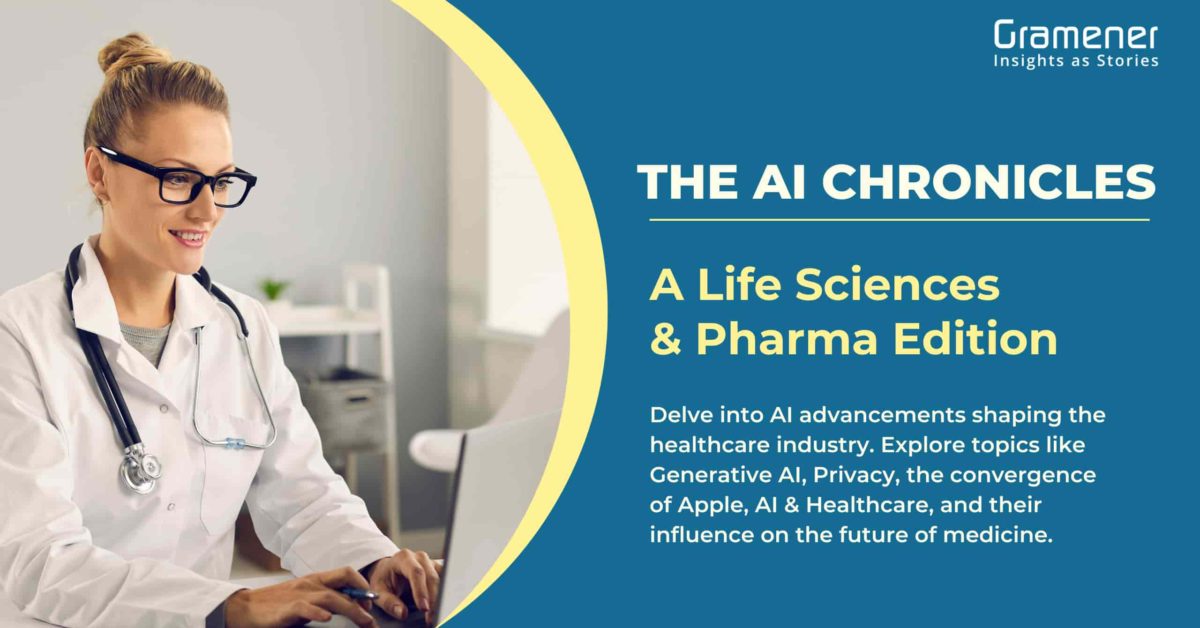Welcome to the AI Chronicles Series! Don’t forget to explore the other three episodes of the series.
- The AI Chronicles #2 – McKinsey’s 5-step digital transformation for Pharma companies, Sanofi’s AI approach to employee productivity, and more on digitization of medical data.
- The AI Chronicles #3 – Find content in images and videos with Microsoft’s Vector, Washington’s new health privacy law, and the importance of personalization in healthcare.
- The AI Chronicles #4 – AI Chronicles #4: AWS HealthScribe revolutionizes clinical documentation, Roche’s report underscores digital tech and data management, and Pytrial aids clinical trials with Generative AI.
Introducing the AI Chronicles!
Through this monthly blog series, we will give you a ringside view of the latest updates in technology, their impact on the life sciences and biopharmaceutical industries, and Gramener’s practical take on how your business can benefit from these new technologies.
In this inaugural edition, we will talk about 3 much-hyped (and for a reason!) technologies. Read on to know more.
Table of Contents
Generative AI in Pharma
What is it About?
There is a lot of buzz about Generative AI, Large Language Models, and GPT. McKinsey has an interesting review – Exploring opportunities in the generative AI value chain – about how fast this technology is being adopted and what its outlook looks like. Here are some snippets:
- In just five days, one million users flocked to ChatGPT, OpenAI’s generative AI language model that creates original content in response to user prompts. For comparison, Facebook had to wait ten months to build the same user base.
- Generative AI outputs have been jaw-droppingly impressive, winning digital-art awards and scoring among or close to the top 10 percent of test takers in numerous tests.
- To begin with, the underpinnings of generative AI systems are appreciably more complex than most traditional AI systems. Accordingly, the time, cost, and expertise associated with delivering them give rise to significant headwinds for new entrants and small companies across much of the value chain.
What does it Mean?
As McKinsey puts it, the generative AI application market is the section of the value chain expected to expand rapidly and offer significant value-creation opportunities to incumbent tech companies and new market entrants. Companies that use specialized or proprietary data to fine-tune applications can achieve a significant competitive advantage over those that don’t.
Patient Data Privacy
What is it About?
Different avenues of healthcare data collection, sharing, and privacy requirements have created a complex field for data science teams in life-science and biopharma organizations. Researchers at Nantes University recently published an interesting article- Patient-centric synthetic data generation, no reason to risk re-identification in biomedical data analysis – where they presented a new method to generate synthetic data of individual granularity while holding onto patients’ privacy.
What does it Mean?
Pharmaceutical companies often face conflicting demands from government agencies enacting data privacy regulations & researchers who require data transparency. For example, Health authorities like EMA, Health Canada, etc., have put into place regulatory requirements for disclosing data for submissions that have to balance between transparency & privacy. Several methods of privacy-preserving data science practices are emerging that combine synthetic data generation, redacting and anonymizing datasets, and redaction techniques.
Read More: Privacy in Healthcare: An Introduction to Protecting Patient Data
Apple, AI, and Healthcare
What is it About?
Several media reports indicate that Apple is developing an AI-powered health coach called Quartz. The coaching service will reportedly use artificial intelligence and data from Apple Watch to create personalized coaching programs for users, focusing on improving exercise, sleep, and eating habits. While the service will not be announced this year, it is expected to be released next year.
What does it Mean?
Healthcare data from consumer devices such as smartwatches, fitness trackers, and wearables has revolutionized the personalized healthcare approach. According to a report by IDC, the global wearable device market is expected to reach 132.6 million units in 2022, up from 73.3 million units in 2018. With this fast-paced adoption will come challenges of integrating this data with the rest of the healthcare data being generated and then applying data analytics techniques to make sense of these combined datasets.
The Gramener Take
At Gramener, we are committed to employing new technologies to empower the pharma industry to unlock untapped opportunities, accelerate research and development, and ultimately transform healthcare for the better.
We are working on several use cases for incorporating LLMs across the spectrum of natural language processing (NLP), natural language understanding (NLU), and natural language generation (NLG). We are especially excited about a human-in-loop approach to generating structured documents for biopharma regulatory submissions and summarizing and analyzing large document repositories for better insights.
In reference to patient privacy protection, we have also devised an NLP-driven data redaction solution for a global healthcare organization to tackle this problem. The solution uses Named Entity Recognition techniques to manage patients’ PHI (Protected Health Information) & PII (Personally Identifiable Information). There are multiple NLP use cases in healthcare, from using NLP to anonymize clinical trial records to handling patients’ personal information.
Using an automated process that involves entity detection, extraction, relationship management, and anonymization, our solution reduces the turnaround time from days to hours. This helps the clinical study teams meet the stringent deadlines of regulatory bodies with relative ease.
Talking about healthcare data, Gramener’s low code framework – Gramex, enables data scientists rapidly build enterprise-grade custom applications, enabled by ready-to-use Microservices, Data Connectors, Processors, Pre-built Libraries, Models, Visual Analytics & Storyboard Templates. Our work with the governments of Singapore and India has showcased our capabilities in analyzing and providing insights from large healthcare datasets.
Stay tuned for the next edition of AI Chronicles!


I’m keen on diving more deeply into the innovative work process behind new medications. Might you at any point share a few experiences on that in your future posts?